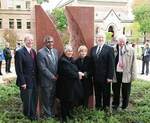Reconciliation set in stone
 Reconciliation Reconciliation
The University of Adelaide's strong support for national reconciliation is now quite literally set in stone. A new sculpture unveiled on the University's North Terrace frontage on 1 June was created as a visual symbol of commitment to the reconciliation process and to the support of Aboriginal and Torres Strait Islander communities through education. "The University developed a formal Reconciliation Statement in 2003 and its impact has been significant," said the Vice-Chancellor and President, Professor James McWha. "We asked the artists to capture the spirit of that statement in their work and we are delighted with the result." The three-metre high granite sculpture was created by Indigenous artist Karen Casey and public sculptor Darryl Cowie - with assistance from 64 willing participants who took part in a handshake ceremony during last year's Reconciliation Week celebrations at the University. Plaster imprints were taken of each handshake, and the castings are central to the final sculpture. They appear as both positive and negative shapes in a manner reminiscent of a fractured rock shelf containing fossilised forms. "The Reconciliation Sculpture is an innovative and exciting work and one that will reward regular viewing," Professor McWha said.
"It reflects our commitment not just to support and further the process of reconciliation, but also to acknowledge the traditional owners of this land, the Kaurna people, alongside those who were instrumental in creating this fine university." The sculpture is located in Goodman Crescent, a major pedestrian thoroughfare which links the Mitchell Building, Elder Hall and Bonython Hall. Nearby statues honour two of the University's early benefactors - Sir Thomas Elder and Sir William Watson Hughes. As a part of the launch guests placed reconciliation messages in a time capsule to be locked away for 10 years. The success of last year's initial event also is still being felt. Ms Casey and Mr Cowie have since held two similar Let's Shake events in Melbourne and hope to collect 1000 "handshakes" by 2008 for public exhibition. "It is a great concept. This sculpture is important to us because as a University community we firmly believe that acknowledgement of the past is vital if we are to achieve the genuine sense of reconciliation that Australia seeks," Professor McWha said. Story by Nick Carne
|





